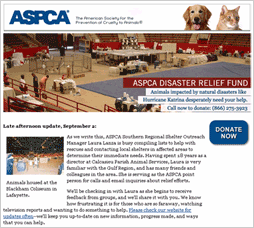|
Sept/Oct 2005 Non-Disaster Groups Use Internet for Real-Time Katrina Responseby Fred Waugh, Vice President, Product Management and Marketing, Convio
Early indicators suggest that when the numbers are tallied, more dollars will have been donated online after Hurricane Katrina than for any previous relief effort. Much of the initial response has been directed to well-known on-the-scene, disaster relief organizations such as the American Red Cross. But in addition to the immediate human needs, many nonprofits are addressing damage to the economic, cultural, and educational institutions affected by Katrina. Many of these organizations are not as well-known as the major disaster relief agencies or if they are widely recognized, most people to not associate them with disaster response. They therefore may not be an obvious choice for potential donors. Yet since Katrina, these groups have been using the Internet to raise funds beyond all expectations and, in numerous cases, are setting online fundraising records for their organizations; one humane organization raised more funds through its Web site in one day than it had in the previous year. The methods these nonprofits have employed are instructive for all charitable groups. Internet Campaign Preparedness: The Importance of Building an Email House FileNonprofits that are not typically considered disaster relief groups face the challenge of making potential donors aware of their relief efforts. They probably are not among the organizations that came to mind first after the hurricane. How are they getting the word out? For many, a key success factor was proactively building an opt-in email file months and even years before the disaster hit. Having the list in place allowed these groups to immediately alert supporters about their needs and communicate exactly how they are and will continue assisting disaster victims.
In the days following Hurricane Katrina, UJA Federation of New York used its email file to notify constituents of the need for water, food and shelter for storm victims. Additionally, during a crisis such as Katrina, organizations actually experience significant email file growth. As they communicate with email, recipients actively forward messages to friends and colleagues. Many of those individuals, in turn, donate to the organization and opt in to receive future email communications from the organization. Micro-Campaigning: Keeping the Message in Front of ConstituentsKatrina is the latest major event to demonstrate the importance of micro-campaigns. Many organizations used this type of online communication following last year's tsunami in Southeast Asia. A micro-campaign may include dedicated online donation forms (where funds can be reported separately from general donations), special Web pages, and sometimes a unique page wrapper or other branding element that immediately identifies the campaign as a special project or program. Internet tools that allow for creation of independent sites (with relevant domain names and distinct page wrappers) are an advantage, as are tools that allow for easy creation of multiple donation forms. A micro-campaign also features related online communications — such as daily updates — to keep donors aware of an organization’s progress and convince donors who are "on the fence" to give. During a crisis, the normal rules for how often an organization should communicate with its donors — including for appeals — can often be suspended. As always, organizations should monitor opt-out rates and other feedback, but multiple appeals can significantly drive up total giving.
The ASPCA quickly notified constituents through email of its work to rescue animals affected by Katrina, and has provided daily updates on relief efforts. Search Engine MarketingPeople who want to learn more about the effects of Katrina are turning to Internet search engines like Google. Nonprofits buying keywords are experiencing significant jumps in both Web site traffic and overall giving. It's a tactic that can help lesser known organizations engage in fundraising for needs the public may not be aware exist.
Many nonprofits are buying keywords on popular search engines to raise constituent awareness of their work. ConclusionEven nonprofits that have not yet developed extensive email files can use the Internet as a critical component of a disaster relief communications and fundraising strategy. They need to devote time and energy to sharing information online. Katrina has far reaching implications for many nonprofit organizations at the national, regional and local levels. Constituents are seeking information on topics as diverse as taking in hurricane victims to speaking with children about the tragedy. Web sites and email newsletters are the primary channel for delivering this time-sensitive information. Nonprofits should ensure that their organizations' Katrina efforts have primary space on their Web sites. In addition, special editions of email newsletters are not only appropriate, they are expected. In all communications, organizations should encourage constituents to spread the word. A nonprofit should specifically ask constituents to notify others about its work and financial needs. Finally, nonprofits should remember to communicate the impact of their organizations’ work. Immediate stewardship is especially important for Internet donors who have contributed to the effort. Have a colleague who might be interested in this topic? Why not forward this article? |
|

 Hurricane Katrina relief efforts provide a big reminder of the vital role nonprofits play in today's society. In these early days of the response, forward thinking organizations — of all sizes and with varying missions — have proactively used the Internet to increase awareness of their work and the importance of raising funds for helping people and communities recover in coming months and even years.
Hurricane Katrina relief efforts provide a big reminder of the vital role nonprofits play in today's society. In these early days of the response, forward thinking organizations — of all sizes and with varying missions — have proactively used the Internet to increase awareness of their work and the importance of raising funds for helping people and communities recover in coming months and even years. 


